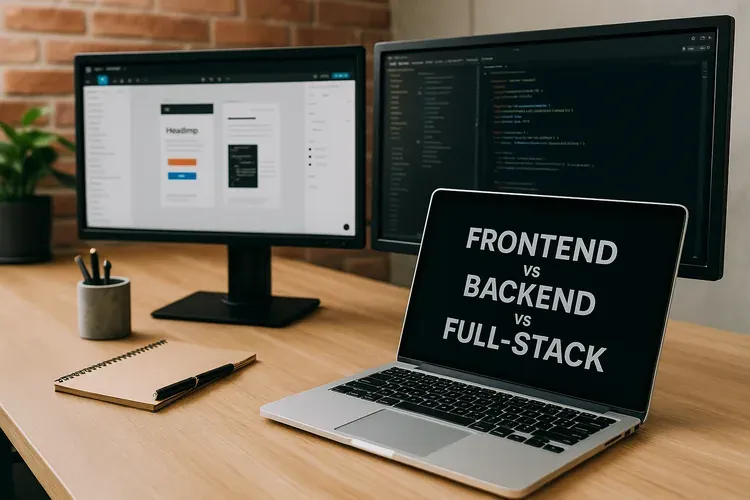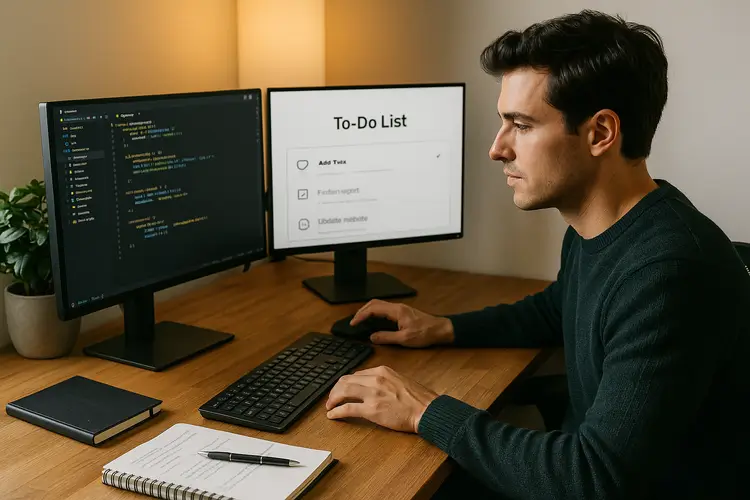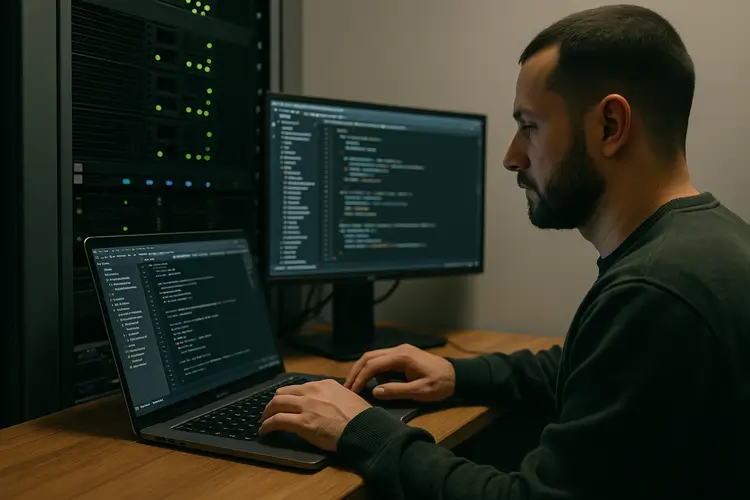Frontend vs Backend vs Full-Stack: Which Path Fits You?
Updated on October 26, 2025 7 minutes read

Choosing a developer path is easier when you understand what each role does, the tools you’ll use, and how those choices impact hiring.
This guide explains frontend, backend, and full-stack work in clear terms so you can pick a direction, build proof of skill, and get job-ready fast.
If you want structure and real projects that ship, explore our bootcamps at Code Labs Academy: Explore programs or Book a free consultation.
What each path actually means
Frontend focuses on the user interface layouts, components, forms, accessibility, performance, and everything visitors see in the browser.
It blends coding with UX and visual detail to create responsive, inclusive experiences.
Backend powers the logic and data APIs, databases, authentication, payments, queues, and security.
It’s about reliability, scalability, and clean architecture behind the scenes.
Full-stack spans UI + server, letting you design features end-to-end, ship quickly, and collaborate across the whole system.
It rewards breadth, discipline, and iterative delivery.
Who typically enjoys each role
If you love visual polish, micro-interactions, and turning designs into smooth experiences, you’ll likely enjoy frontend work.
You’ll care about responsive layouts, semantics, and Core Web Vitals.
If you prefer data models, clean APIs, and problem-solving around performance and security, backend might be your lane.
You’ll think in flows, contracts, and failure modes.
If you want to own a feature from spec to deploy, full-stack gives you range.
You’ll touch React one hour and a database migration the next—and that variety can be energizing.
A week in the life (realistic tasks)
A frontend week often includes building components, connecting to APIs, improving a11y and performance, and refining edge cases on forms.
You’ll collaborate closely with designers and product managers.
A backend week includes designing REST/GraphQL endpoints, writing queries and migrations, handling auth, and adding telemetry for observability.
You’ll document contracts for teammates and plan for failures.
A full-stack week mixes both: plan a slice, build UI and API, write tests, deploy, and watch metrics.
You’ll coordinate with product and move features across the finish line.
Core skills and tools that get you hired
Frontend roles expect HTML, CSS, JavaScript (or TypeScript), accessibility, and a modern framework like React.
You’ll learn state management, routing, testing, and performance tuning.
Backend roles expect one server language such as Python or Node/TypeScript, a solid grasp of SQL, ORMs, background jobs, security basics, and API design.
You’ll write contracts that are clear, stable, and well-documented.
Full-stack roles combine both with DevOps basics—Git, CI/CD, environment variables, error monitoring, and a simple deployment path.
“Just enough DevOps” is often enough to start.
Want a curated, project-first path? Our Web Development bootcamp covers frontend, backend, and deployment with real-world projects.
Explore Web Dev.
How to choose (simple decision guide)
Ask yourself what feels more satisfying: pixels and user journeys, data and systems, or end-to-end problem solving.
Your preference will make practice enjoyable and consistent.
If you’re unsure, start full-stack with small vertical slices.
You’ll discover which side you naturally lean toward, then double down.
Remember, paths are permeable. Many engineers switch lanes after a few projects.
Skills compound across the stack.
The signals employers actually screen for
Hiring managers look for shipped work with a live demo, a clean README, and a few tests.
They want to see structure, reasoning about trade-offs, and error handling.
They also value clarity: a short Loom walkthrough, documented env variables, and “how to run tests.”
These small touches show you can collaborate in a real team.
If you’re building a portfolio from scratch, our programs help you produce interview-ready projects with reviews and feedback.
See the structure here: Explore programs.
Portfolio ideas mapped to each path
A frontend-leaning project could be a SaaS dashboard with charts, filters, pagination, and keyboard-friendly navigation.
Tie it to a real API and add Lighthouse-visible performance wins.
Another strong choice is a form-heavy app with validation, multi-step flows, and accessible components.
Emphasize error, loading states, and mobile responsiveness.
A backend-leaning project could be a task queue + scheduler with retries, idempotency, and monitoring.
Expose a documented API and include unit and integration tests.
Another option is an auth service with JWT sessions, refresh tokens, roles, and rate limiting.
Show careful handling of edge cases and security headers.
A full-stack project can be a feature-complete CRUD app such as a course catalog with search, auth, and payments.
Keep scope tight, but document next steps and trade-offs.
Add one AI-assisted feature such as text summarization or tagging.
Keep it simple, log failures, and show UI fallbacks.
Learning path that keeps momentum high
Start with foundations: HTML/CSS, JS/TS, Git, and CLI comfort.
Practice by cloning simple pages and adding features without frameworks first.
Choose one framework—most commonly React.
Learn routing, forms, data fetching, and component composition.
Introduce APIs and data: fetch data, manage state, handle auth, and cache responses.
Learn why certain endpoints exist and how contracts reduce bugs.
Add tests progressively: a few unit tests per feature and one integration test for critical flows.
Tests are hiring signals and reduce fear when you refactor.
Learn deployment early. Use a simple PaaS or containers with a minimal CI pipeline that runs tests.
Add error monitoring so you can spot issues like a professional.
Skills by path
A frontend foundation includes semantic HTML, modern CSS, TypeScript, React, accessibility, performance profiling, and Testing Library or Vitest.
Highlight: a11y and Core Web Vitals.
A backend foundation includes Node/Express or Python/FastAPI/Django, SQL with migrations, caching, background jobs, auth patterns, and contract-first API design.
Highlight: API ergonomics.
A full-stack foundation combines both with Git hygiene, CI/CD, environment management, and basic cloud.
Highlight: vertical slices from spec to deploy.

Common pitfalls and how to avoid them
Frontend beginners often over-engineer state or ignore accessibility.
Keep state local when possible, test tab order, and budget time for performance.
Backend beginners may build brittle data models or test only the “happy path.”
Design for rollback, write integration tests, and document non-goals.
Full-stack beginners sometimes attempt too much at once.
Ship thin slices, add observability early, and keep a “what’s next” section.
Career progression and typical titles
Frontend engineers grow into Senior Frontend, UI Engineering, or Design Systems roles.
Expertise in accessibility and performance becomes a strong differentiator.
Backend engineers grow into Senior Backend, Platform, Security, or Data Engineering roles.
Strength in reliability, queues, and observability stands out.
Full-stack engineers grow into Senior Full-Stack, Tech Lead, or Product-minded Engineer roles.
Ownership of outcomes and cross-team communication matters most.

“Do I need DevOps to get hired?”
You need just enough DevOps to deploy reliably and run tests automatically.
A simple CI pipeline, environment variables, and error monitoring will take you far.
As projects grow, you can layer on containers, CD, and infrastructure as code.
Start at the smallest slice that increases confidence and team trust.
Tip: Treat deployment like a feature. Document it, automate it, and keep it boring.
Interview preparation that matches reality
Practice requirement → design → implementation → tests → demo as a narrative.
A short video showing decisions and trade-offs answers implicit interviewer questions.
Keep READMEs crisp with setup, scripts, and “assumptions.”
Add notes on performance, security, and what you’d do with more time. Show thinking.
Use small pull requests with meaningful commit messages.
Hiring teams read history to understand how you work, not just what you shipped.
Where Code Labs Academy fits in
Our Web Development bootcamp teaches frontend, backend, and full-stack with a project-first approach and weekly code reviews.
You graduate with deployed projects and tests that stand out on resumes.
If your interests tilt toward data or security, we also offer Data Science and Cybersecurity tracks with hands-on labs and hiring prep.
You’ll get mentoring, interview practice, and a portfolio plan tuned to your path.
If you want clarity and momentum, pick one of these and commit for two weeks.
Build one shippable feature, add tests, and record a short demo.
Visit our program pages to see curriculum and outcomes, or talk to an advisor for a custom plan.
Explore programs and Apply now.
Or talk to an advisor for a custom learning plan: Book a free consultation.
Summary
Frontend suits creators who love interfaces and UX. Backend suits problem-solvers who enjoy data, security, and reliable systems.
Full-stack suits builders who want end-to-end ownership and fast iteration.
Whichever path you choose, focus on small, real projects, clear docs, and basic tests.
These signals get you into interviews—and help you succeed once you’re there.